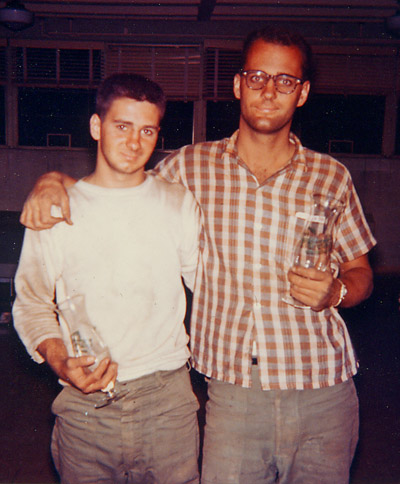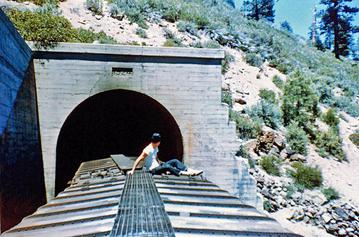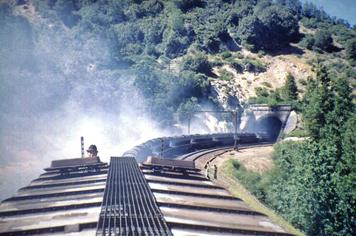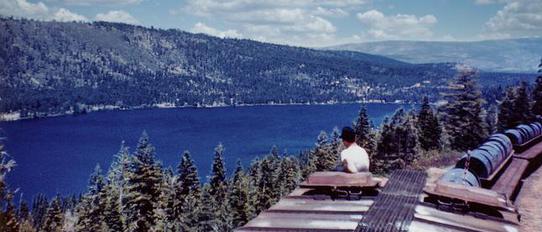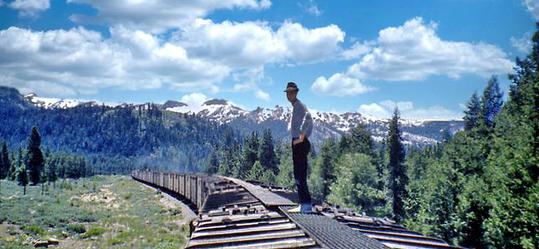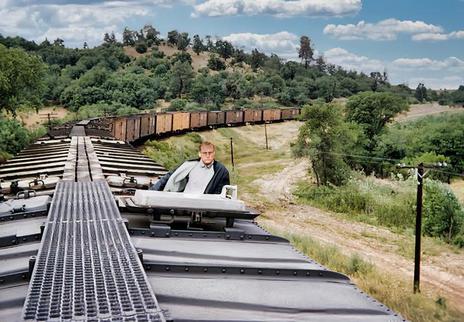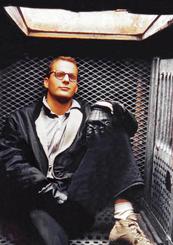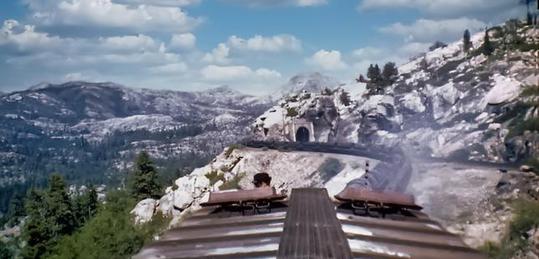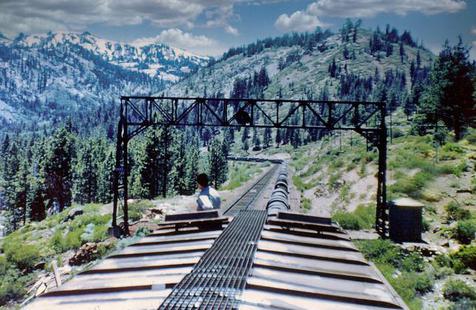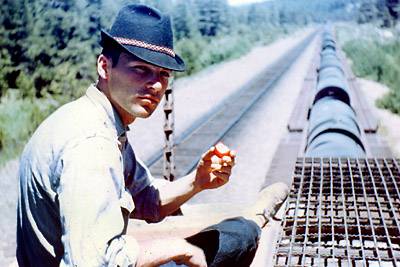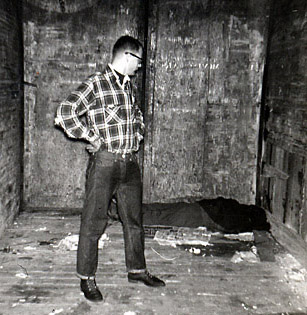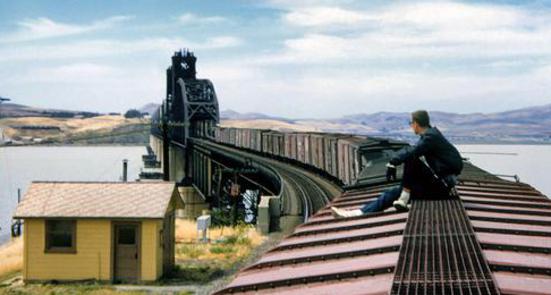 | ||||||
a migratory laborer and a tramp is a migratory non-laborer and a bum is a non-migratory non-laborer."
In my youth I probably fit into the last category, I'm sure my mom thought so. But "My Bum Days" doesn't make for a good title, although I had my share of them. It was the 1950s. I was in love with railroading and influenced by Jack Keroac's "On The Road" life style. The folk movement was in full swing and Bob Dylan, Woodie Guthrie and Pete Seeger were singing ballads romanticizing life on the rails.
It was also safer back then. The skull-cracking railroad bulls of the 30's and 40's were legends of the past. Security was lax and most trainmen were friendly and helpful, at least to polite, clean-cut youths. The murdering gangs (FTRA - Freight Train Riders of America) that would threaten the lives of any who took to the rails was still in the future. Of course, the physical risks were extremely high. Hopping on and off a moving train is very dangerous, and the memory of running along the catwalks and jumping from car to car as the train rocked and pitched beneath us still sends icy shivers up my spine.
My Happy Hobo Days
by Peter Hoffman
The catwalks are gone now, as are the brakemen who once walked them. There are no more ladders to the tops of the cars which have become inaccessible. And "riding the rods", referring to the truss rods under the cars that supported the flooring, were, by my time, pretty much history. I would like to think that as a young man today I would have the sense to find other avenues of excitement. There is a time for everything, and the time for riding the rails has passed, to be remembered best in song and tale.
Railroad fans love everything to do with railroading. "Catching out" was for me an adventure made in heaven. I seldom rode by myself, but when I couldn't talk a friend into going along, I would head out solo and take my chances. Although my friends were not
Crossing the Carqueniz Straits between Martinez and Benica, California on the Southern Pacific.
Oklahoma Slim, better known as "The Mayor of Beverly" was quoted as saying: "A hobo is
Westbound out of
Reno, snow still mantles the Sierras late in June
as we approach Donner Pass
Climbing the eastern slope, Donner Lake belies its infamous past.
The empty Pacific Fruit Express refrigerated cars were were our first choice to ride. At each end on the top there were compartments where block ice was loaded to chill the fresh fruits and vegetables. When the cars were empty, we could open the hatches and jump in and ride in a clean and protected space. When standing
Right, an entire train of
empty reefers highballing through the Sierra Nevada foothills
near Auburn, California.
The refrigerater car ice bunker was clean and cozy, and protected us from the elements. Whenever possible we sought out empties to ride on the westbound trips.
Brewing some hobo coffee; boiling grounds in an old tin can on the Western Pacific in Portola. We sure could have used this brew in the freezing snow sheds on Donner Pass.
One of those "bum" days. We had no railroad schedules and chanced jumping trains at random, sometimes waiting in adverse conditions. Gordon's enthusiasm is clearly evident as we wait for a train in the rain.
Returning to Fort Sam Houston after a monumental trip from San Antonio to New Orleans and return on a 3 day pass, Carl and I proudly display our hurricane glasses from Pat O'Briens in the French Quarter. No photos were taken on any of my southwestern treks.
Our train descends the western slope near Yuba Gap, while inside the
ice bunkert only Chapman's head is showing.
Potentially noxious.smoke fumes were a hazard in many of the longer tunnels. Sometimes it seemed we would never get out.
Smoke from hot brakes clings to the train while the high-pitched squealing sounded like a thousand stuck pigs.
into railroading, they usually couldn't resist my enthusiastic sales pitch of a unique adventure. Sometimes I think they regretted it. Hardships were commonplace. It could be freezing cold or baking hot. Many times we would be without food for long stretches. It was impossible to get any decent sleep and it was always very, very dirty. Fortunately, all my pals and I returned home safely. I hope they still share my fondness of these memories, both the good times and the bad. These unique experiences can no longer be duplicated.
You never knew who else might share your box car. We rode this empty for almost eight hours before we realized we weren't alone. But the bum on the floor never joined our party.
Round tripping from Oakland to Reno was a weekend favorite. My buddy Gordon, who was in the Navy and stationed in Long Beach, would hitch-hike to Oakland early on Friday. That night we would ride his motorbike to the Oakland 16th Street Station and stash it under the abandoned stairway to the old second floor electric train terminal. We'd catch the first freight out and hope it was going to Reno. In those days freights ran almost every hour and we usually didn't have to wait long. Returning Sunday afternoon, Gordon would scrub up, put on his uniform and hitch-hike back to Long Beach for Monday morning duty. You can't find a more devoted and thrill-seeking friend.
Catching a freight in the right direction didn't always lead to the right destination.
On one trip we woke up to see Mt. Diablo and realized to our dismay that our car had been cutout and sent off on a branch line to Walnut Creek. Twelve hours after we left Oakland we were only 25 miles from our starting point. Totally disillusioned, we rode a Greyhound bus home. On another trip, I hitched a 75 mile ride between freight yards.
But most hops took us to our intended destination, although not entirely without interruption. On the trip to Reno the railroad crosses the Carquinez Straits between Martinez and Bencia (see opening photo). The first time I crossed this bridge was in the wee hours of the morning. I vividly remember the mistique of a full moon reflecting off the waters far below as the
bridge girders flashed by my open boxcar door. Early that morning my section of the train was set off on a siding in Fairfield and before I was able to reboard, the train was off without me. I spent the remainder of the night on the freight platform praying that another train would stop, while listening to the mighty cab-forward steam engines as they highballed past with consists destined for Reno.
On one such trip in June the weather was delightfully warm and Gordon and I departed dressed
with only light jackets. In the middle of the night our train stopped in the snow sheds at Norden just shy of Donner summit. In short order we were absolutely freezing and jumped off to see what was happening. Southern Pacific maintained a large maintenance facility completely enclosed under a system of snow sheds, with long enclosed walk- ways between buildings. We found our entire train crew inside warming themselves by a pot-bellied stove drinking hot coffee. We probably could have joined them but were too apprehensive to declare our presence. After what seemed like hours we finally were under way again, and as we exited the snow sheds we were flabbergasted to find nearly 12 inches of snow on the ground.
You would think after that I would have learned about the weather and temperatures in the mountains, but my memory was short lived. The next year I was with Chapman and sure enough we froze once again. This time the train didn't stop but continued on down the eastern slope high above Donner Lake. We were riding on a flat car and the wind chill was killing us. It was freeze or find another spot, so we were forced to run along the tops of the cars in the dark looking for a protected place. There was only enough light from the moon to see a short ways ahead. The train was really rolling and the cars were rocking and bouncing from side to side. While one car was rolling left the next one was rolling right, and jumping between them was terrifying. We found a private railroad business car on the rear of the train just ahead of the caboose and we were able to gain shelter huddled on its open platform.
This experience was enough to sour Chapman on
being a "Bo", but he recovered somewhat on the return
trip which was both scenic and pleasant (see series of three photos above). But his spirit and pride took a fall on reaching Roseville, where the train stopped to change crews. As we were slowing down I jumped off, holding on to the ladder until my feet were moving the same speed as the ground before letting go. Chapman, either too tired or really not aware of the technique, took a tumble and went rolling in the cinders. Immediately the yard loudspeakers squealed and a deep voice boomed out from the tower, "Better teach your friend how to get off before you ride again."
we were about waist deep to the cars roof, giving us a great view of the train and countryside. The hatches were quite heavy and there was no chance of them shutting accidentally. And we could duck down inside to avoid detection. My dad, before he died, was Superintendent of Car Service for PFE. If he could have seen us riding in his cars he would have turned over in his grave. But maybe he was watching over us because we never had a problem.
In the late 1950's I was in the Army and stationed at Fort Sam Houston in San Antonio, Texas. My buddy Carl and I had never been to New Orleans which was about 550 miles distant. We arranged for three day passes, headed to the freight yards in early evening and jumped an east bound freight before dark.
The next morning when we awoke we found our train stopped in the middle of a fog-shrouded swamp, complete with black water and moss draped-trees and undoubtedly every kind of poisonous snake known to man. Getting out to see if our car had been set off on a siding or if the train was still intact was not on our agenda. Before we could consider other alternatives we were knocked to the floor as the train got underway and we arrived in New Orleans shortly after noon.
Well, in New Orleans wasn't quite correct. The rail yards are in Algiers which is on the west side of the Mississippi River while New Orleans is on the east side! Undaunted, we decided to hoof it. I think the rail yards were designed by some medieval castle architect. It was surrounded on three sides by swamp, and our intended direction took us across about a quarter mile of muck. By the time we emerged on the far side, we were covered with mud and slime to mid-thigh.
We caught an antique street car which took us across the Hewy P. Long Bridge and into the heart of the French Quarter. Looking and smelling like a couple of swamp rats we strolled down Bourbon Street and into the famous Pat O'Brien's bar. O'Brien
served fancy drinks in tall hurricane glasses which tourists could take home as souvenirs. To make short of a long story, we drank up, retraced our steps to the railroad yard and caught the next freight home, carrying our glasses back to San Antonio as our only proof of our adventure.
Several months later I was itching for the rails again. It had been almost two years since I had been home to California, and I missed it dearly. So my goal was to ride from San Antonio to Yuma and return, and then walk over the Colorado River bridge into California. I had no idea if I could accomplish this on another 3-day pass, but I was game to try. My plan was to ride as far as I could in half the time I had and then to turn around and head back. If I turned up AWOL it would be hard to explain what I had been doing to the Company Commander.
Buying a canvas reclining chair at the Salvation Army store for $.75, I set it up on a flat car and reclined in true hobo style. You should have seen the looks I got from the waiting passengers when my train passed through the San Antonio station. Disbelief mixed with waves and good cheer. Truthfully, I was kind of embarrassed. After a few hundred miles my luxurious accommodations ended as the chair disintegrated from heavy bouncing over rough rails. Once again I was scrounging for old cardboard boxes to lie down on.
There were many bad types on this trip. Fortunately, I made friends with several good natured hobos who warned me to stay clear of the others. I took their word for it, because these guys themselves looked pretty tough on their own. They warned me the others were armed and dangerous. I don't doubt them to this day. The railroad right-of-way passes within a stone's throw from the Mexican border for long stretches in both Texas and Arizona. Border patrol jeeps raced for miles on dirt roads alongside the train while they checked us all out with their binoculars. To what end I can't say, as they never stopped or boarded the train, and there were lots of Hispanics aboard. On this trip my companions gave me the moniker "The California Kid".
Arriving at Yuma I was behind schedule and I ran across the bridge just to be "home" for a minute, bending down an kissing my native soil. Incredibly corny yes, but I was a homesick soldier who had been stationed far from the "hip world" too long.
The vastness of the southwest is overwhelming when experienced from the perspective of a lonely freight train, rolling hour after hour, day and night, through the endless deserts of Arizona and New Mexico. As sleeping was difficult, many waking hours were spent gazing out over the desert as the miles roll by under the moonlight with millions of bright stars overhead. In 72 two hours I had crossed and re-crossed half of Texas and all of Arizona and New Mexico in my quest to reach California, a roundtrip of 2,100 miles.
Even though I had sent a postcard from Yuma to my army buddies at Fort Sam none of them would believe I had accomplished the trip on a freight train. Only Carl, my previous companion on the trip to New Orleans, looked on without commenting, for I knew he knew I had done it. He couldn't hide his disappointment in not tagging along with me on my incredible journey.
Chapman playing the part. Oh how I'd love
to locate him now, after almost 70 years, and
learn his reaction to this tale.
Climbing the eastern slope of the Sierra Nevada Mountains toward Donner Pass. To my recollection, this was my final ride.
The moaning of a steamboat never stirs my soul.
"Aeroplanes and autos always leave me cold,
The only thing that makes me want to navigate
Is a wildcat whistle on a southbound freight."**
"I know I'm old enough to quit
this running 'round,
I've tried a hundred times
to stop and settle down.
But every time I find a place
I'd like to stay,
I hear a freight train holler,
and I'm on my way."
**Freight Train Blues
So what impelled me to put my life in jeopardy and endure the hardships of riding the rails? Part of the answer lies in the question. It was the thrill of danger and the challenge to overcome and endure. It was the excitement that came when the immediate future was unknown. Where would I be at this time tomorrow? Where would I go from there? Did it really matter? Not at all. It was the freedom to choose life as it was encountered. Where choices directed events but then left the results completely to fate, requiring in a short time more choices to negotiate an endless stream of forks in the road. Life was simplified. Responsibilities and obligations did not exist. It was eat, sleep and move on to a new place and a new day.
I felt a great sense of history, of railroading and of pioneers, of the colorful past of life on the rails. A life that was never meant to be but was forced upon good people out of economic necessity. But mainly, I think, it was sharing an addiction with many of those bygone travelers of a deep and incurable wanderlust.
"The California Kid"

Visit the California Kid's other railroad sites:
Popular Youtube Video:
Photo Essays
In 2008 William T Vollmann published "Riding Toward Everywhere" a literary work of art based on train hopping. Booklist praised it thusly: "Intrepid journalist and novelist William T Vollmann's colossal body of work stands unsurpassed for its range, moral imperative, and artistry . . . . Rhapsodic, mischievous, and profoundly receptive to life in all in beauty and harshness, this daredevil writer of conscience pays homage to those who have praised the freight-train life before him----Thomas Wolfe, Hemingway, and Kerouac----and channels his own wild romanticism into burning critique of our commercialized world and a paean to freedom and compassion."
Reading the book I was astounded by Vollman's ability to capture the spirit, analyze the philosophy and
describe the essence of train hopping with a deep yet simple insight. I would like to share with you a few
excerpts from his book, and encourage you to read it in its entirety.
Guitar Whitey, in his excellent book "Ridin' Free", one of the finest insights to the hobo culture, relates a story about a bo called the "California Kid" out of Southern California. There is no connection bewteen that person and myself. My only regret is that I was not privileged to meet Whitey while riding the rails, but did so at the 2013 meet in Dunsmuir.
Stories
 | ||||||
